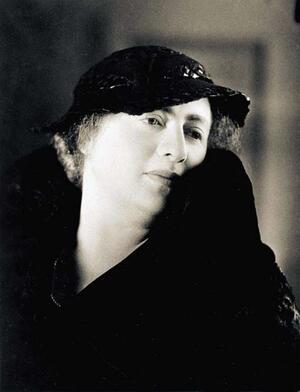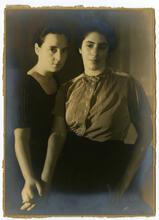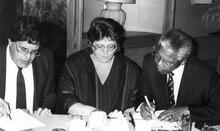Irma Stern
Irma Stern was a remarkably prolific artist, holding more than a hundred solo exhibitions. Stern was the daughter of German-Jewish parents who came to South Africa around 1886. Stern’s first exhibition in South Africa was held at Ashbey’s Gallery in Cape Town. In the staid, colonial art world of Cape Town, the vitality and exuberance of her work shocked and outraged critics and audiences, and even sparked a police investigation into complaints of public indecency. It took time for Stern's espousal of modernism, color, and rhythm to find acceptance in the conservative art world of South Africa. Some of her earliest support came from South Africa’s culturally progressive Jewish community. After her death, the Irma Stern Museum, administered by the University of Cape Town, was opened.
“Searching, I roamed the world—to arrive at the origin—at beauty—at truth—away from the lies of everyday—and my longing was burning hot—then the darkness opened up and I stood at the source of the Beginning—Paradise.” (Irma Stern’s Private Journal, 1919–1924).
For Irma Stern, one of South Africa’s most outstanding artists, Africa was her “Paradise,” the intellectual and emotional mainspring of her artistic creativity. She occupies a unique place in the history of modern South African art and her works are to be found in many galleries and public collections in South Africa and abroad. She was essentially a product of two worlds. Although born in South Africa, her background, education, and culture were European. However, it was Africa that provided the inspiration and canvas for her art.
Early Life and Family
Irma Stern was the daughter of German-Jewish parents, Samuel and Hennie Stern, who came to South Africa around 1886. Samuel Stern first opened a small shop in the Graaff-Reinet district of the Cape Colony but later became a successful farmer in Schweizer-Reneke, Transvaal, where Irma was born in 1894. In 1899, when Samuel Stern was interned by the British during the Anglo-Boer War on account of his pro-Boer sympathies, Irma and her mother left for Germany, returning to South Africa only at the end of the war in 1903 when the family relocated to Wolmaranstad in the Transvaal.
Irma and her parents traveled regularly to Germany where there were strong family connections, particularly in Berlin. In 1913 Irma left South Africa to study art at the Weimar Academy in Germany but, dissatisfied with the tuition there, she transferred her studies to the Levin-Funcke studio in Berlin. However, it was only when she met Max Pechstein (1881–1955), a leading member of the German Expressionist group known as Die Brücke, that she felt she had found a true mentor. Between 1918 and 1919 her works were included in a number of exhibitions in Germany and she held her first solo exhibition in Berlin in 1919, after which she returned to South Africa.
Art Career
Irma Stern’s first exhibition in South Africa in 1920 was held at Ashbey’s Gallery in Cape Town. In the staid, colonial art world of Cape Town, the vitality and exuberance of her work shocked and outraged critics and audiences, eliciting abusive descriptions such as “Agonies in Oils,” “Lunatic inspirations,” and “Insults to human intelligence,” and even a police investigation into complaints of public indecency! It took time for her espousal of modernism and her primary tools of color and rhythm to find acceptance in the conservative art world of South Africa. Some of her earliest support came from South Africa’s more culturally progressive Jewish community.
Over the next few years, public opinion in South Africa was positively influenced by the acknowledgement she received when she exhibited abroad in Germany, France, and England, particularly when she was awarded the Prix d’Honneur at the Bordeaux Exhibition in 1927. She was also selected to represent South Africa at the Empire Art Exhibition in London in 1929.
In 1926 Irma Stern married Johannes Prinz, then professor of German at the University of Cape Town. The marriage was most unsuccessful and ended in divorce in 1934.
Irma Stern constantly sought new visual experiences through travel. In particular, her journeys to Zanzibar in 1939 and 1945 and to the Congo in 1942 provided the stimulus for a flood of creative work that marked the high point of her career. At a time when travelers hesitated to penetrate “darkest Africa,” Irma Stern disappeared for weeks into central Africa, where her expeditions produced many fine studies of indigenous people.
Her artistic vision came to be valued both at home and abroad, and Irma Stern was the recipient of many awards, including the Molteno Grant for outstanding work (1952), the Guggenheim Foundation National Award for South Africa (1960), the Oppenheimer Award (1963), and the Medal of Honor of Die Suid-Afrikaanse Akademie vir Wetenskap en Kuns (1965). She was also chosen to represent South Africa at the Venice Biennale in 1950, 1952, 1954, and 1958.
Legacy
Irma Stern was a remarkably prolific artist, holding more than a hundred solo exhibitions. Plans were being made for a major retrospective exhibition of her work at the Grosvenor Gallery, London, when she died in 1966, just two months short of her seventy-second birthday. Although best known for her paintings, Irma Stern also worked as a sculptor and ceramicist. She was a discerning collector of art and artifacts and her home in Rosebank, Cape Town, was a veritable treasure house of exquisite arts and crafts from all over the world.
On Irma Stern’s death, her home and its contents became a national legacy. In 1972 the Irma Stern Museum, administered by the University of Cape Town, was opened.
Exhibitions
1919, 23, 27, 32–Galerie Gurlitt, Berlin
1920, 21, 22, 25, 26, 29–Ashbey’s Galleries, Cape Town
1925, 27–Galerie Goldschmidt, Breslau
1925, 29–Galerie Goldschmidt, Frankfurt
1926–Levson Gallery, Johannesburg
1926–Champion’s Art Gallery, Bloemfontein
1929–Galerie le Triptyque, Paris
1927, 29, 32–Galerie Billiet-Vorms, Paris
1928–Galerie Themis, Brussels
1929–Galerie Nierendorff, Berlin
1929–Kestner Gesellschaft. Hanover
1929–Galerie Wurthle, Vienna
1930–Galerie van Lier, Amsterdam
1930, 32, 35, 37–Galerie Kleikamp, Den Haag
1932–Foyles Gallery, London
1933, 38–MacFadyen Hall, Pretoria
1933–Lazard Galleries, Johannesbirg
1934–Newlands House, Cape Town
1934–University of Stellenbosch, Stellenbosch
1935, 36–Selwyn Chambers, Cape Town
1935, 36–The Criterion, Johannesburg
1935, 46–Durban Art Gallery, Durban
1937–Cooling Galleries, London
1937–Leger Gallery, London
1937, 38–Martin Melck House, Cape Town
1939–Sun Buildings, Cape Town
1939–Transvaal Art Gallery, Johannesburg
1940, 42, 47, 49, 51, 56–Gainsborough Gallery, Johannesburg
1941, 42, 43, 44, 45, 46, 47, 48–Argus Gallery, Cape Town
1942–Musée Ethnographique, Elisabethville
1945, 46–Bothner’s Gallery, Johannesburg
1947–Wildenstein, Paris
1948–Kunst Kring, Rotterdam
1948–Roland Browse & Delbanco, London
1948–Van Eeckmann, Velp
1948–Christie’s Gallery, Pretoria
1949, 50, 51, 52, 53, 54, 55, 57, 58, 61, 63, 64–South African Association of Arts Gallery, Cape Town
1953, 65–Gallery Andre Weil, Paris
1955–Van Schaik gallery, Pretoria
1955, 60–Galerie Wolfgang Gurlitt, Munich
1956–Stadt Gallerie, Linz
1956–Galerie Wassmuth, Berlin
1959–Regency Gallery, Cape Town
1959–Albini Gallery, Cape Town
1960–Stadtische Gallerie, Salzburg
1960–Staat Gallerie, Berlin
1961–Fielding Gallery, Johannesburg
1962–Lidchi Gallery, Cape Town
1965–Walter Schwitter Gallery, Pretoria
1966–Wolpe Gallery, Cape Town
1967–Grosvenor Gallery, London
1968–Rembrandt Art Centre, Johannesburg.
Alexander, F. Art in South Africa Since 1900. Cape Town: 1962.
Berman, E. Art and Artists of South Africa. Cape Town: 1983.
Dubow, Neville. Irma Stern. Cape Town: 1974.
Dubow, Neville, ed. Paradise: The Journal and Letters 1917–1933 of Irma Stern. Cape Town: 1991.
Sachs, J. Irma Stern and the Spirit of Africa. Pretoria: 1942.
Schoeman, Karel. Irma Stern: The Early Years 1894–1933. Cape Town: 1994.





